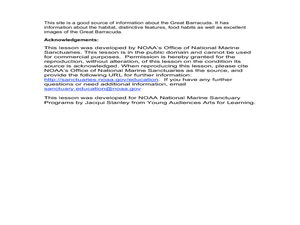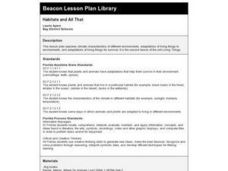Curated OER
Light at the Bottom of the Deep, Dark Ocean?
Students participate in an inquiry activity. They relate the structure of an appendage to its function. They describe how a deepwater organism to its environment without bright light.
Curated OER
Wildlife
The centerpiece of this lesson plan is a predator-prey simulation in which colored paperclips represent different species of animals camouflaged against a colored background. Relevant follow-up questions are provided. The activity is...
Curated OER
Follow a Fish
Students choose a fish from anywhere within the Ocean Center. They observe it for a given time, recording its behavior. Students comprehend the concept that living things have individual characteristics that enable them to live in their...
Curated OER
ROV Grid Search
Students perform activities to recreate the exploration of the sea bottom. They attach magnets to the bottom of the remote controlled car to see how many camouflaged objects it can pick up. As a class, students examine the results of...
Curated OER
The Eyes Have It!
Reading essays about deep-sea expeditions open this lesson on crustacean vision. Marine biology explorers study the compound eye and then complete a worksheet in response to all they have discovered. Although the lesson doesn't offer an...
Curated OER
Bioluminescence
Middle schoolers discover the concept of bioluminescence. They identify marine animals who have use this and why. They work together to test the function of bioluminescence as camouflage.
Wilderness Classroom
Ocean Life
Our oceans are composed of many complex relationships. Young oceanographers explore relationships between organisms, understand the world ocean's currents, and discover the effects of water pollution and how it behaves. There are...
Curated OER
The Great Barracuda
Students explore oceanography by researching the great barracuda. In this animal life lesson, students read several vocabulary terms dealing with ocean life and examine a drawing of a barracuda. Students examine the many...
Curated OER
Fish Fashion 101
Young scholars explore fish anatomy. For this fish anatomy and adaptation lesson, students define and identify the location of fish body parts. Young scholars add these parts of a fish's anatomy to a life-sized fish costume worn by a...
Curated OER
Adaptations of Penguins
In this adaptations of penguins worksheet, students write short answers describing 14 ways penguins are adapted for their living environment.
Curated OER
Geometry: Practical Applications of the Distance Formula
Young scholars, working independently and in groups, apply the distance formula to practical situations. After solving various problems, students in pairs design coordinate planes from the school blue print to measure the distance from...
Curated OER
Habitats and All That
First graders read books, complete online explorations and discuss the ways in which animals adapt to their habitats in order to survive. They create accordion books, play matching games and dramatize animal adaptations.
Curated OER
Predator/Prey Activity: Fish Feeding, Environments, and General Behavior
Students explore concepts of environment and survival among different marine life, focusing on the ocean environment.
Curated OER
Introduce Vocabulary: I See Animals Hiding
Students are introduced to the story " I See Animals Hiding" and define key vocabulary words from the story. In this lesson aimed at reinforcing vocabulary, students listen to the usage of vocabulary words in the story. Students...
Curated OER
What's Bright Red and Invisible?
Students study that very little sunlight penetrates the ocean below depths of 200 meters. They study that no light penetrates the ocean below depths of 1000 meters. They study that the quality of light changes as depth increase
Curated OER
Survival of the Fittest
Sixth graders create their own "never before seen" marine creatures and examine how not all creatures in the sea swim, not all have sharp teeth
National Wildlife Federation
Penguin Fun Facts
What's black and white and can dive up to 1,800 feet under water? That's right, penguins! Learn this and many other amazing facts about these unique birds with this handy reference sheet.
Curated OER
Head to Foot
Students describe the body form and major anatomical structures of squids and describe some unusual or unique features of newly-discovered deep water squid species. They infer what types of food squids use from their anatomical features.
PBS
Secretes of the Ocean Realm: Creatures of Darkness
A PBS series site designed for educators to teach students the concempt of bioluminescence in marine life.
TED Talks
Ted: Ted Ed: Underwater Astonishments
David Gallo shows jaw-dropping footage of amazing sea creatures, including a color-shifting cuttlefish, a perfectly camouflaged octopus, and a Times Square's worth of neon light displays from fish who live in the blackest depths of the...
California Academy of Sciences
California Academy of Sciences: Dwarf Cuttlefish
A behind the scenes peek at the Dwarf Cuttlefish (Sepia bandensis) a native to the Indo-Pacific region of the ocean around Indonesia, Papua New Guinea and the Philippines. Watch as crabs get dropped into the tank, and the cuttlefish move...
Scholastic
Scholastic Instructor: Teaching With Pourquoi Tales
This site features activities that revolve around "Teaching With Pourquoi Tales." Students will learn more about these types of old legends that deal with the natural world.





















